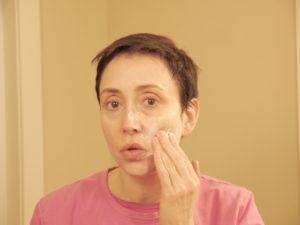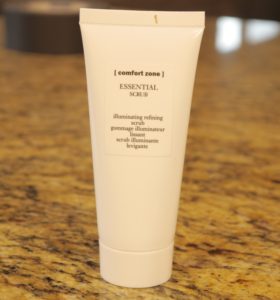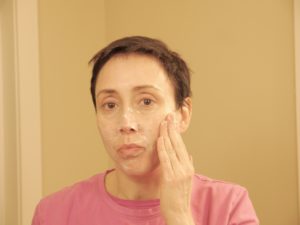Exfoliation
How do we achieve the perfect radiant glow? While daily cleansing and moisturizing is needed to maintain great skin, the key to glowing skin is through exfoliation. Exfoliation treatments can help with skin rejuvenation, elasticity and collagen and removes dead skin cells from the surface. It will help tired, scarred or old skin look fresh and soft.
We’ve all been taught that the formula for clear, beautiful skin starts with a proper cleanse. However, many of us leave out an important step, and that is exfoliation. Exfoliation is the removal of dry/dead skin cells on the surface of the skin and is one of the most important aspects of your home skincare routine for face and body.
Exfoliation not only helps many skin problems, it also increases blood circulation, which in turn helps you to achieve healthy and glowing skin. Throughout the year, our skin goes through changes and is forced to adapt to the revolving seasons. To keep your skin smooth and bright all year round, exfoliating is the key to success.
When you’re younger, your skin will naturally renew itself about every 25 days. When you reach the age of 30, the process begins to slow down, which can result in more pigmentation as well as a duller complexion.
Exfoliants come in many shapes and sizes. Whether you choose a manual or chemical exfoliant, they will help to achieve younger, more radiant skin. With regular exfoliation comes great skin. Not only does it remove dead skin, it also reduces skin discoloration and pigmentation, fine lines and wrinkles.
Mechanical exfoliation calls for the use of a tool that will act to physically remove dead skin cells from your skin’s surface. This tool can be a physical instrument like a brush, sponge, or hand-held scrubbing disk. You can also use a face scrub to mechanically exfoliate your skin. Have you ever noticed that when you go to the beach and walk around in the sand, the calluses soften on your feet? Sand is a type of physical exfoliation, granules which are sloughing off dead skin cells from the body.
 Chemical exfoliation involves the use of salicylic acid or alpha hydroxy acids (AHAs) such as a glycolic acid to dissolve dead skin cell buildup from the surface of your skin—no scrubbing necessary. Keep in mind that AHAs like glycolic acid can leave your skin sensitive to the sun, so make sure to apply a broad-spectrum sunscreen with an SPF of 30 or higher as directed in the morning. Take other sun protection measures as well, including limiting your amount of time in the sun (especially during the sun’s peak hours of 10 a.m. to 2 p.m.), seeking shade, and covering up exposed areas in long sleeves, pants, a broad-brimmed hat, and UV-blocking sunglasses.
Chemical exfoliation involves the use of salicylic acid or alpha hydroxy acids (AHAs) such as a glycolic acid to dissolve dead skin cell buildup from the surface of your skin—no scrubbing necessary. Keep in mind that AHAs like glycolic acid can leave your skin sensitive to the sun, so make sure to apply a broad-spectrum sunscreen with an SPF of 30 or higher as directed in the morning. Take other sun protection measures as well, including limiting your amount of time in the sun (especially during the sun’s peak hours of 10 a.m. to 2 p.m.), seeking shade, and covering up exposed areas in long sleeves, pants, a broad-brimmed hat, and UV-blocking sunglasses.
Chemical exfoliants dissolve keratin protein and break apart the bonds (desmosomes) between the skin cells. AHAs are the most common of chemical exfoliants and are naturally occurring acids derived from plant sugars. These ingredients, in particular Lactic Acid, have the ability to stimulate hydration in the skin by increasing the glycosaminoglycans which bind water within the epidermis. Ceramide levels increase, which improves the barrier function of the skin, which results in increased collogen production. We see a decrease in fine lines, hyperpigmentation and hyperkeratosis. However, AHAs, because they’re water soluble, can’t penetrate very deep into pores. Unlike BHAs.
By contrast, BHAs (beta hydroxy acids) are oil-soluble molecules. They can reach deeper into the skin and pores. BHAs also have anti-inflammatory and antibacterial properties—a more in-depth exfoliation in general. This type of chemical exfoliator is recommended with those with acne-prone, oily skin. If blackheads are a concern, stick to BHAs.
Is it possible to use both? Yes! Since AHAs and BHAs work in different ways to exfoliate the top layer of skin, it is in fact safe to use both. BHAs break down the bonds between cells while AHAs cause the cells themselves to detach.
Fruit enzymes like papain (papaya!) and bromelain (pineapple!) are perfect exfoliants for those with sensitive skin—they’re not nearly as harsh as BHAs or AHAs. Fruit enzymes break down the keratin in skin and target only the outermost layer of the epidermis. Enzymes are biological catalysts which enable chemical reactions in the skin. Papain (Papaya), Bromelain (Pineapple) and Bacillus Ferment all eat away at dead skin cells, revealing a healthier epidermis underneath. (Keep this in mind the next time you have irritated gums after eating pineapple…you have just exfoliated your mouth!)
It is important for people with blemished skin to use an exfoliator on the face or body at least twice a week. Some people believe the best way to stop a break-out is to strip the skin, killing bacteria, but, this will also dry out the skin and cause irritation. We would suggest removing dead cells while keeping the skin clean and hydrating with a good moisturizing lotion – lighter than a cream – making sure that you apply the lotion with clean hands to prevent bacterial infection and spots. After having a blemish on the skin there can sometimes be a dark mark left for a while. The best way to fade these dark marks is to exfoliate twice a week to remove those damaged skin cells and encourage new healthy skin tissue to grow through. If you suffer from clogged pores, exfoliation helps to draw out congestion, otherwise known as blackheads and whiteheads. Most common areas for breakouts are the nose, chin and forehead. Remember, twice a week max.
Pigmentation is the dark areas that come from age, pregnancy and changes in your hormonal balance. These areas tend to become more apparent and darker as the skin ages. Exfoliation is beneficial for breaking up pigmented cells, encouraging them to fade. Regular targeted facials are also good to help promote healthy skin reproductions, helping these areas to fade. If your skin is dry or dehydrated, you may find scaly or flakey areas which would benefit hugely from exfoliation. Once you have exfoliated an area of dry skin you can apply a moisturizer to the new skin cells.
When you have your legs or bikini line waxed you are pulling the hair from the root. Although the hair will eventually grow back weaker, it sometimes cannot pierce through the skin and a red spot will appear around the hair. This is an ingrown hair – exfoliation to the area will remove dead skin and allow the hair to break through the skin.
Because you are increasing blood circulation, breaking down toxins and encouraging new skin cells to come through, our best advice is to drink lots of water which drains toxins and helps give those new skin cells a “drink from the inside”. It is important to apply a good moisturizer to hydrate the skin from the outside in. Also, do not expose your exfoliated skin to UV rays and the sun.
When you exfoliate the body, you are increasing the blood circulation and lymphatic system which is very beneficial for the body, this helps encourage new skin cells, breaks down fatty tissues, and breaks down and drains toxins from the skin. After exfoliating, the skin is left beautifully soft and ready to absorb a good moisturizer.
Waxing your face is also a form of exfoliation! So, if you are planning on waxing an area on your face, make sure you avoid exfoliating your skin before and after your wax to prevent and damage or discomfort from occurring. Make sure you don’t scrub your face too often, and when you do, scrub lightly. Rubbing too hard and too frequently will only cause more harm than good to your skin.
Before exfoliating, it is important to remember to take off any makeup and give your skin a proper cleanse and tone. If you don’t, the exfoliation will not be able to give you the deep clean you are looking for. Proper exfoliation is the key to glowing, healthy skin; it minimizes pores, reduces breakouts and acne, fights aging, and allows absorption of other products. Who knew a gentle scrub could do such wonders to your skin!
Skin Care 101 continues with Serums
